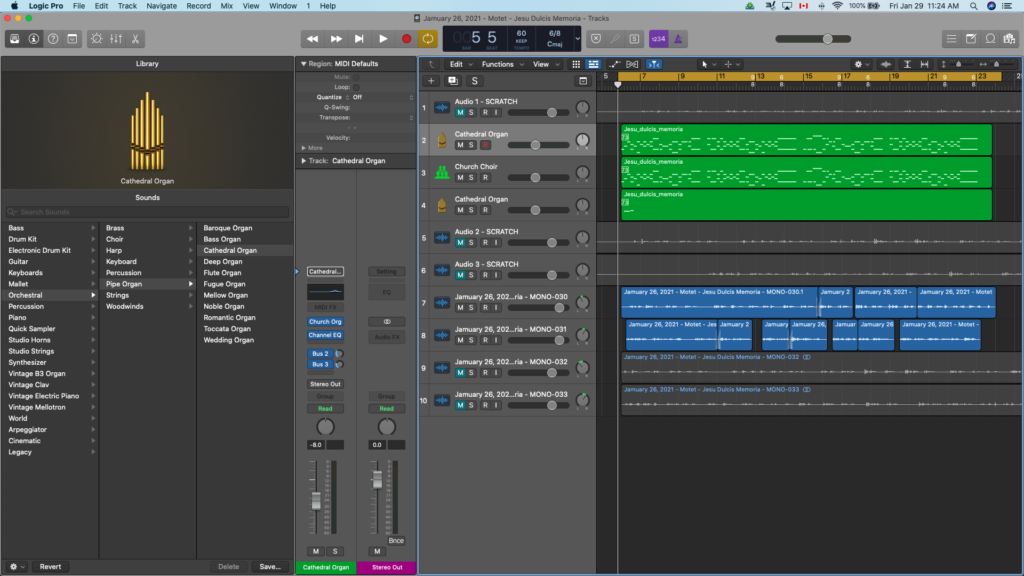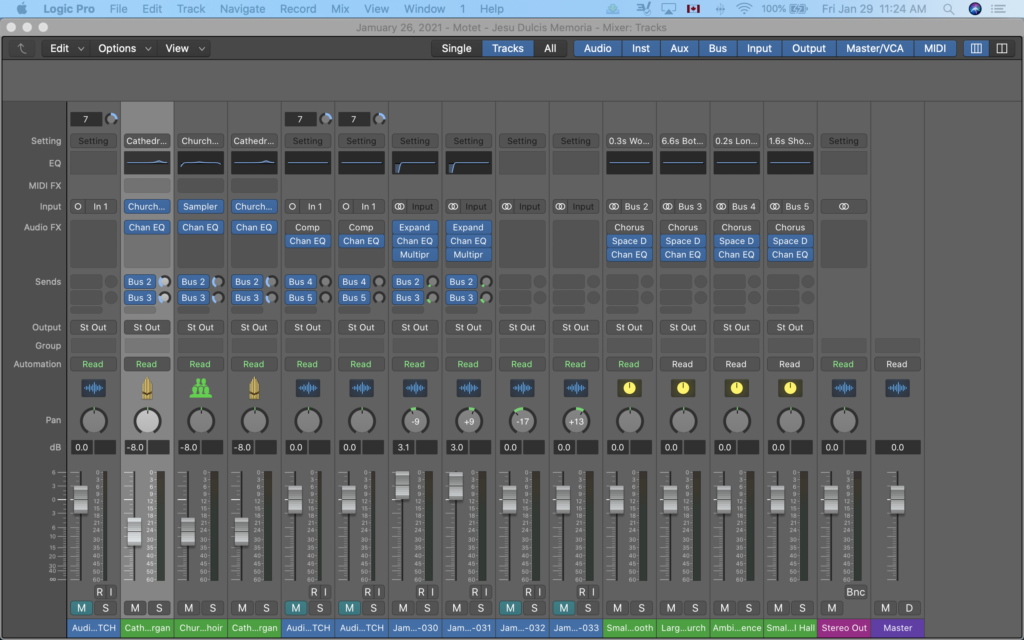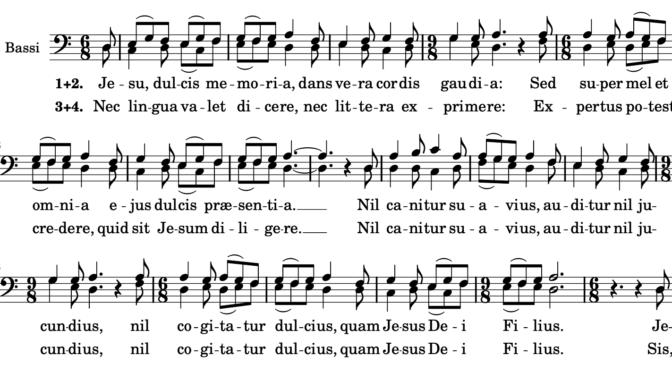Some of the challenges put forth this month proved to be a touch more difficult than I would have thought. Not only did I have to read up on what the style was but, once I knew what it was, I also had some difficulty determining how I would best go about accomplishing the task. Today’s is an example of that challenge:
Due to time constraints, I’ll have to write up a review a bit later. Enjoy the track until then!
For those who are not familiar with what a motet is, it’s a type of Christian liturgical hymn written in Latin. If it’s not written in Latin, then it’s called a madrigal.
Does it have to be Christian? Well, that’s where things change. The motet originally was only for liturgical purposes but, as it spread in use throughout Churches, it found its detractors and that’s when secular, often vulgar, motets came into being.
I focused on the Christian motets, specifically those written in its earliest days. Jesu Dulcis Memoria, attributed to Bernard of Clairvaux, is dedicated to Jesus and his inspiration to humans. The words of the motet are are follows:
| Jesu dulcis memoria dans vera cordis gaudia: sed super mel et omnia ejus dulcis praesentia. |
Jesus, sweet remembrance, Granting the heart its true joys, But above honey and all things Is His sweet presence. |
| Nil canitur suavius, nil auditur jucundius, nil cogitatur dulcius, quam Jesus Dei Filius. |
Nothing more pleasing can be sung, Nothing gladder can be heard Nothing sweeter can be thought Than Jesus, son of God. |
| Jesu, spes paenitentibus, quam pius es petentibus! quam bonus te quaerentibus! sed quid invenientibus? |
Jesus, hope of the penitent, How merciful you are to those who ask, How good to those who seek, But O, what you are to those who find! |
| Nec lingua valet dicere, nec littera exprimere: expertus potest credere, quid sit Jesum diligere. |
Tongue has no power to describe Nor writings to express But only belief can know by experience What it is to love Jesus. |
|
Sis, Jesu, nostrum gaudium, |
Be our joy, O Jesus, |
|
Amen. |
Amen. |
| http://www.cpdl.org/wiki/index.php/Jesu_dulcis_memoria | |
Now, you might wonder why I would choose such a motet given its heavily religious nature.
First, it’s a song form I’ve never done before but I’ve always liked Gregorian chants.
Second, as I was debating whether or not to sing it, this was one of the easier motets available.
Third, it fits with the liturgical calendar. That is to say, January 26th is the feast day of Saints Timothy and Titus, but I couldn’t find any motet dedicated to them. Further, the day falls into what’s called “Ordinary Time”. Ordinary time refers to the time between the Christmas and Easter seasons which mark the birth and death of Jesus.
Fourth, I could find a MIDI track that would act as a guide. I used the copy from the Choral Music Wikipedia. (http://www.cpdl.org/wiki/index.php/Jesu_dulcis_memoria)
In other words, it’s a generic motet that can be used just about any time.
(I should also add that it is religious so my Mom might like it too, even though I only read the words instead of sing them.)
The motet song form is made unique by the way it is sung and is one of the most challenging features of the style. If you’ve ever heard monks singing, especially the Gregorian monks, they are usually singing in the style of how a motet would be sung. These aren’t one-note-one-syllable type of songs. Rather, motets feature a lot of moments when one syllable will be extended over a range of notes and over a lengthy amount of time.
For example, here are the opening lines to Alleluia – Exsultate deo adjutori nostro:


The motet is only two lines, yet the opening Alleluia takes up the whole first bar. It’s common for motets to have words that are sung over several notes but those words aren’t always in one specific location in the stanza, but can vary, something which I couldn’t really figure out.
Now, most singers out there would look at that think it would be a challenge, but not impossible. And they would be right. But I’m not a trained singer and trying to hit those notes wasn’t happening. It’s one thing to sing a hymn with a group of people, it’s another to sing it into a microphone for playback.
I gave it a shot anyway but found that it’s not a style that would be easily picked up and I didn’t want to do the style of song disservice, so I went with what I knew I could do: speak, or “congregational style”. That is, as a part of the congregation (the people who go to church), most of us aren’t formally trained singers so what we tend to do is “sing” in a style that has the tone of the spoken word but the elongated notes of a singing voice. It sounds alright when buried with others, more as a drone note than anything else, but on its own it’s rather dull.
Typically motets are made with four or voices in mind, similar to the four-part harmony style of singing, but there isn’t always a big difference in the tones being used. For example, although four people might be singing, they might be two tenors and an alto or soprano or some similar combination. There may not be a bass singer.
My trouble was that I couldn’t get the singing done in any form but I did have the idea to “chant” the motet, which may have sounded good, too. I went with two voices: one spoken and one congregational style of singing, but found that, if I have the organ playing in the background, then there should be more voices.
I thought about adding a few “ahh” tracks of my own but opted instead to re-use the MIDI track and put the “Church Choir” effect on it. This way the background voices matched the organ and then it sounded like two people had taken the lead in reciting the motet, albeit, it does sound a little disjointed.
As for post production, I had to bring down the levels of the organ and the choir as they were very overpowering in relation to the voices. I panned my voice a little bit to the right and left but left the organ and choir in the centre.

For mixing and effects, I used the default values for the organ and choir but for the spoken voices had to use the Expansion plugin to kill some room noise, a Low Cut Channel EQ, and then a 3-band Multipressor to boost the overall volume a little. I then routed the vocals to the same bus as the organ and choir to give them the same “room” treatment that the instruments were getting.

So that will end my attempt at a motet. It was a good challenge and something I might revisit later on. This style of singing requires a bit more nuance and singing ability than most other types of singing, to the extent that it would probably be more work to sing it and fix it in post rather than to just sing it properly the first time. But, pitch correction, that would be an idea to pursue if I wanted to tackle this style again.
